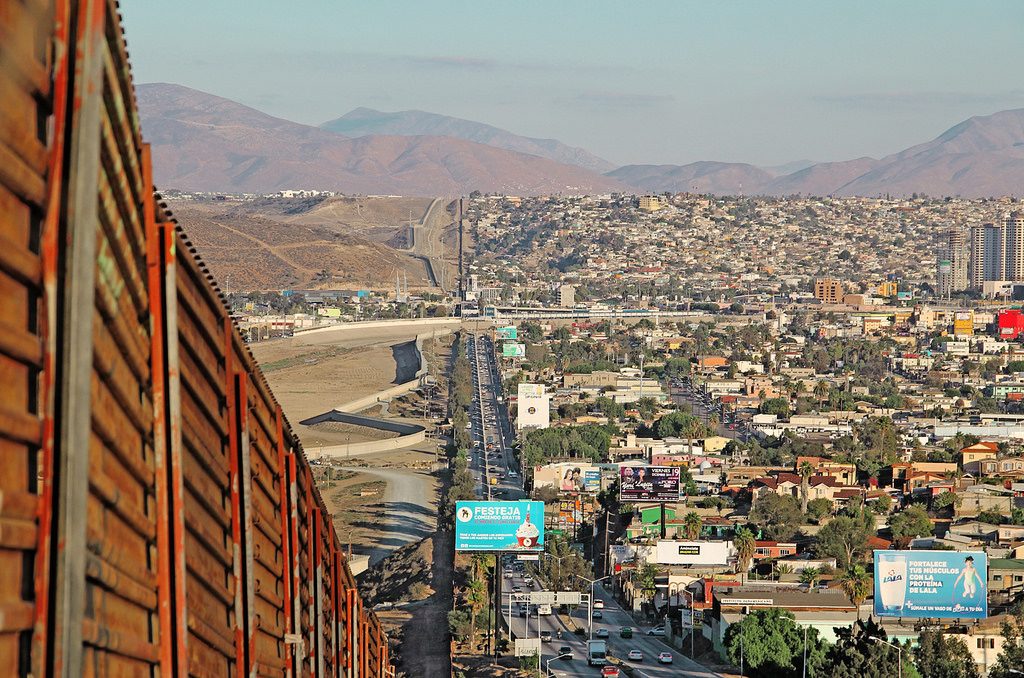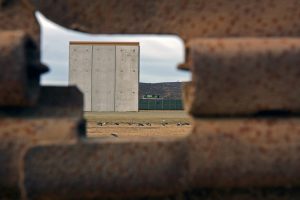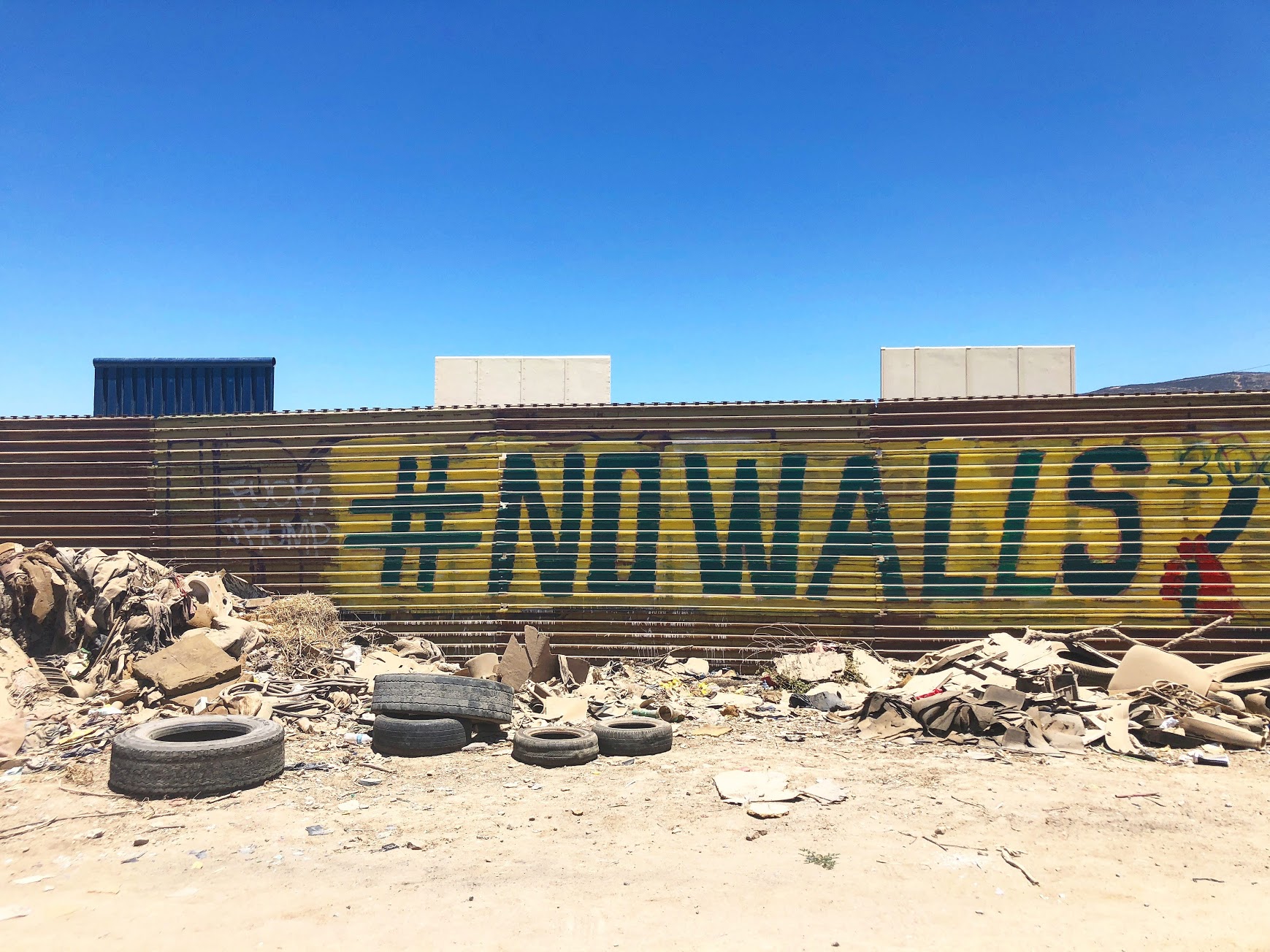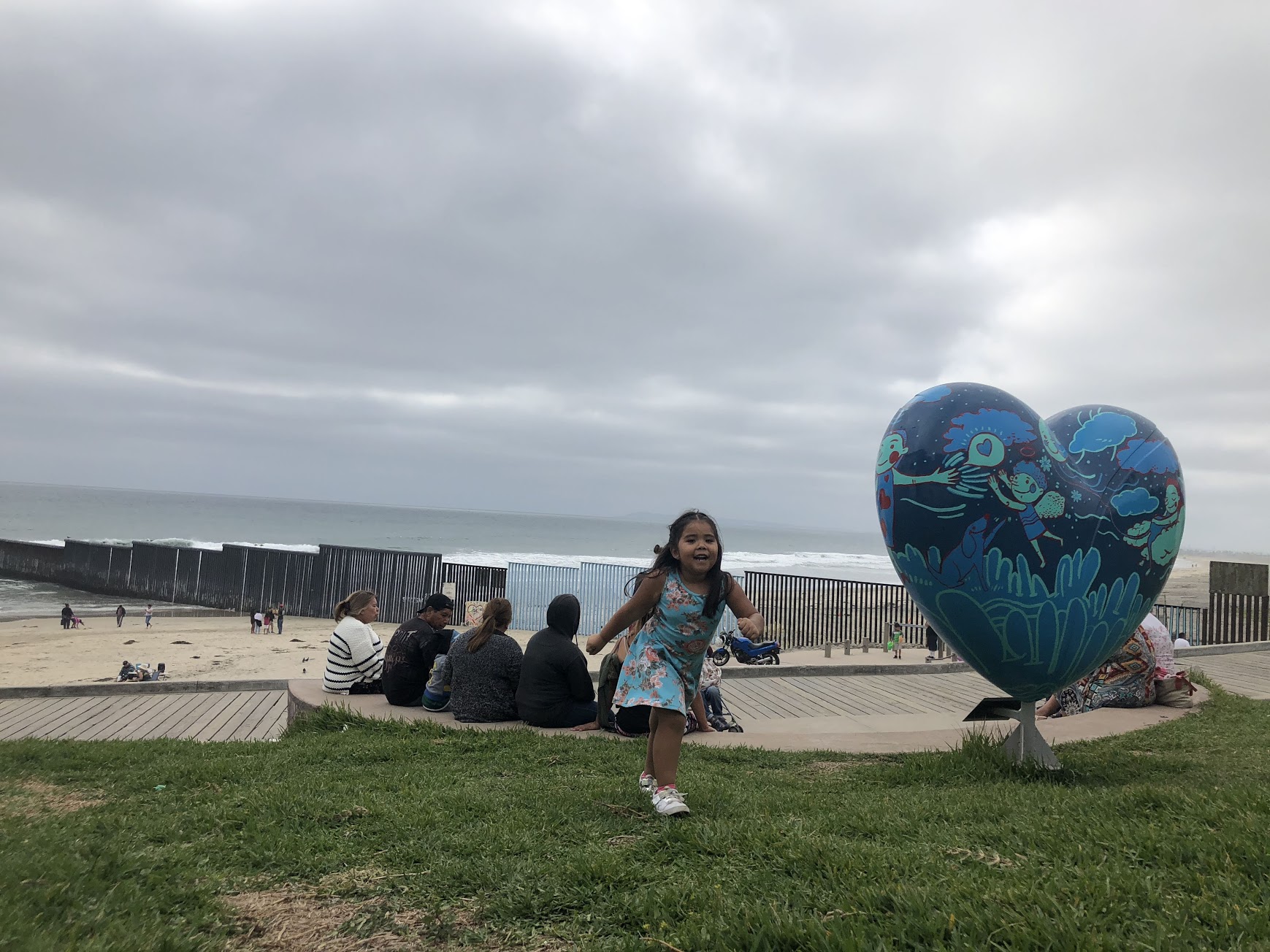It’s a cloudy day and the seagulls flutter over the three-hundred-mile border that separates Mexico and the United States. The birds have a favorite place to lookout: the iron wall that ends in the ocean, in the area referred to as Las Playas de Tijuana.
On the American side, three mounted men can be seen at a distance. The moment the sign “No trespassing” becomes visible they turn around and return to the naval town.
On the other hand, on the Mexican side, there are live music groups playing banda next to the border. There’s so much noise from the adjoining restaurant that it is difficult to hold a conversation.
The musicians wear colorful outfits and play next to a sign that hangs in the middle of the border wall. It reads: “We do care”, this meant as this is intended to be a reaction to the controversial message scrawled on Melania Trump’s jacket on June 21st which read, “I don’t really care.”
Her decision to don that particular jacket during her visit to a shelter for immigrant children separated from their parents on the U.S.’s southern border caused a furor to spread rapidly across social media.
Amongst the visitors who travel across the border is Gonzalo Cortez. It has been ten years since the man, originally from Nayarit, lives in San Diego. He works at a casino and every week he comes to Tijuana to visit his family.
The morning of Sunday July 1st it took him two hours to cross the border. This time he didn’t cross the border to make the traditional family visit. He did it to assist and participate in the new Mexican presidential elections.
“If people had work here [in Mexico], there would be no need to migrate and we would avoid living the suffering of separating from our families”, he laments. But there is something that weighs even heavier on him. Since Gonzalo has double nationality, he confesses that on November 2016 he gave his vote to Donald Trump “because I am against abortion and the legalization of marijuana”. Today he admits that bringing him to power has been counter-productive: “the outcome is worse, things here are very complicated with this president”.
On the night of Sunday July 1st, during his first speech, after being recognized by his main political opponents as the winner of the Mexican presidential race, Andres Manuel López Obrador (AMLO) highlighted his interest in fortifying the nexus between Mexico and the United States:
“With the government of the United States of America we will seek a relationship of friendship and cooperation for development, always locked in mutual respect and in the defense of our migrant countrymen who live and work with honor in that country”.
A day later, at his first press conference with the media, López Obrador communicated that he had held a half-hour phone conversation with President Trump. In it, he proposed to explore an integral agreement between the bordering nations, as well as development projects that can generate jobs in Mexican territory to “reduce migration and improve security”.
These first interactions between AMLO and Trump have a place in a context in which the migration theme carries with it old and complex problems.
Pedro Ríos, member of the coalition “Consorcio Pro Migrantes” in San Diego, thinks that the recent governmental politic coming from the United States has limited the rights of migrants to the point of ignoring international agreements.
The member of the coalition comprised by more than 15 organizations that support migrant communities with the objective of improving governmental border policies observes: “[In the U.S.] they feel freer to not respect the rights migrants hold whether they are undocumented or have permanent residency”.
Amongst the most recent cases, the also president of the Comité de Amigos Americanos refers to “the kidnapping of the right for political asylum to ensure that the congressmen vote for more funds to build the wall extension”.
How to rethink the controversial issues of migration and border in the new era of the governments of AMLO and Trump, remains to be seen.
PROTEST AND HOPE
From the most abandoned area of Tijuana, known as Las Torres, where the great maquilas can be found and no pavement but dirt rising with the wind, the eight wall prototypes built in 2017 can be observed. On Mexican soil it is easy to see the 10-meter-tall wall scraps, made of steel and concrete, while, from San Diego, the border protection restricts the passage of any unauthorized person.
Workers from six different companies dedicated a month to the construction of the prototypes designed to stop the traffic of migrants without the proper documentation to enter the United States and drugs. The employees, who work on a daily basis at the maquilas, do not get used to this landscapedesigned with bars and prevailing colored walls on the other side.
“Let them all burn”, expressed Javier Reyna, one of theelderly workers, who was deported from the United States and separated from his family. “Imagine what it is like for me to see those prototypes daily—he adds—I feel horrible. It makes me angry.”
The contrast cannot be that abysmal. From Tijuana, the short and light grille constructed in 1994, is the “Canvas” of muralists who seek to reunite these two nations through art.
Such is the case of Enrique Chiu, who, after Trump came to the Presidency, initiated a more ambitious project: to paint more than 900 kilometers of border wall with murals.
The paintings with hardened messages seem to scream fiercely at the threatening prototype scraps for the construction of the border wall extension. “No Walls”, can be read on one of the murals painted by Chiu. On Tijuana’s territory these demands are visible to everyone, but few Americans are aware that they exist.
Derrik Chinn, a young American from Ohio, considers it necessary to show this reality to a public that ignores the historically rough bilateral relationship.
Derrik moved to Tijuana 11 years ago to study the history of the city since its foundation. Nine years ago, he started the project “Turista Libre” with the overwhelming objective of showing the United States citizens the Mexican version of a narrative that is barely diffused.
Even though it is announced as a tour, directed to people that visit this border city, Derrik considers it a cultural exchange that lasts six hours, where he shows the locations and landmarks most representative of Tijuana. The most awaited stop is the place where the wall prototypes that President Trump wishes to extend along the border can be seen.
“The first feeling that the tourists have as they observe the prototypes on the other side of the wall is disgust. Many experience distinct reactions like fury, sorrow and pain, some have even shed tears while observing this”, Derrik relates.
Another place he shows on the travel is the picturesque sculpture of “La Mona”, by Armando Muñoz García. The 55 feet tall woman painted in white, with one hand pointing at the sky and the other over the heart, was constructed in 1989 to celebrate the first century of the young Baja Californian capital in representation of the fierce Tijuanense woman.
Not far from “La Mona”, we find Montserrat Bermúdez. The Tijuanense of 28 years old who has concluded her high school degree and has had sporadic jobs as a cashier and travel agent, is happy because she has recently found a job as a receptionist.
“Moving to the United States doesn’t interest me, even though I know that the opportunities are good”, she comments. She recognizes that over there “it is difficult to prosper in that lifestyle, they have more financial stability, but they don’t stop working, they don’t have a balance. In me, the American dream does not fit. I prefer to go to Puerto Vallarta, I wouldmigrate to another place in my country.”
For the first time in many years, the young Tijuanense has gone out for a few beers to a bar on Revolución street with a friend to celebrate her new job. “I feel safe, there is always movement, it’s not like a few years ago when we could only see our friends at houses and we didn’t go out to bars”, she says.
The girl with an affable smile and hair dyed in a electric blue tone comforts herself that there may come new political and social times for the country where she wants to continue to live her life. But what is to come with the new leader that governs the country, it remains a mystery.
“A part of me already knew that he was going to win. I believe that Andres Manuel will not be as bad as the current president, but he has to demonstrate that Mexico made the right decision”.
The movement in downtown Tijuana is evident. In this city, new cultural and commercial projects have begun to gestategiving back hope to those who want to change the social environment of a place that for years sunk in the violence brought on by organized crime.
In recent dates the band “Liquits” played at the iconic “Black Box” bar on Revolución avenue—where the rock and roll movement arose a few decades ago and it represents the hotbed of local, national, and binational music. Rodrigo Velázquez, vocalist of the recognizable Mexican rock group, expressed the artistic importance that Tijuana holds for bands like Liquits.
“For us, Tijuana has always been special, it represents the bellybutton of culture and music.
It is where styles from distinct parts of the world join, it is a cosmopolitan city, in each street corner there is art and proposals, people are surrounded by everything that arrives from all parts of the world”, says the vocalist to Newsweek.
A few blocks from the bar “Black Box” there is a new coffee shop proposal, the “Container Coffee Roaster”, where the Tijuanense Alexis Aceves offers drinks like pure cacao. Known as “The Ferrari of coffee machines”, Marzocco is the equipment that this coffee shop counts on when preparingtheir espressos. In the same way, it counts on a Probat toaster, one of three in all of Mexico.
“There has been a big increase of coffee shops—tells Alexis—there was a greater investment and the clients that demanded better quality in their beverages”, explains Alexis, who works in Container since the beginning of the project.
Every day, four baristas from different places, whether it be from diverse parts of Mexico or the United States, come to work. Their clients are lawyers, doctors and couples visit on the weekends. The profile of their clientele is of a high economic level.
“After closing various coffee shops in Tijuana due to violence, it’s been six years since I was already operating, to open this project of such a scale was an accomplishment, this commercial investment would not have been possible a few years ago”, he reveals. Alexis voted for Andrés Manuel López Obrador and he recognized that he is someone who represents a change for Mexico; however, he still looks doubtful as to how important the transformation that promises so much by the leader who will take office on December 1stwill be:
“We live in Mexico and we are accustomed to politicians making promises and not following through. This is why I have my reservations”. But he shows enthusiasm at the end, “although I do believe that things in this country will be transformed”.
VIOLENT REALITY
Various artists utilize pacific forms of protest to show their discontent with respect to the treatment given to migrants. A project called “Hormiguero” puts art to contribute to social inclusion.
On their shirt designs you read phrases like “Retired thug” or “Ignorance generates crime”. These phrases illustrate some of the problems that one defiant city has faced, and one thatis populated by people who are neither from here nor there: the floating population comes from the south, the north, the Caribbean and they take shelter in this particular border.
60 percent of the 50 thousand people who cross the border daily into the United States live in Tijuana, which has as consequence a city with a strong and buoyant economy.
But the rebirth of the tough Tijuana is not yet a complete reality. Violence has migrated unto other dangerous scenarios, which have not made an impact on the social fabric.
Gonzalo Manrique, coordinator of the master’s in public politics from Universidad Iberoamericana de Tijuana considers that what the city is experiencing is a “digitalization of drug trafficking”.
“The drug trafficker has lost respect. Before he would ask permission, now he even imposes his candidates”, warns the scholar, “what we are experiencing is the death of the drug trafficking chain of production. They don’t operate as before, now it is a digitalization where payment is in kind”.
This past June 5th the number of homicides in Tijuana reached the thousand so far in 2018 and according to reports from the state prosecution 80 percent of cases are related to the selling and buying of drugs.
The independent regidor of Tijuana, Roberto José Quijano Sosa, who was president of the Copamex, explains to this weekly that the problem of violence and the rise in the number of homicides is a consequence of the adjustment of accountsbetween narcotraffickers, given the large number of weapons coming in from the United States through Tijuana. In addition, he says, it doesn’t help that the possession of firearms is no longer punishable by preventive detention.
“There is no institutional capacity for the prevention of crime, coupled with migration and the lack of a response from the procurator’s offices”, explains during the interview with Newsweek en español. And he adds: “the problem is not the population that migrates from the south but the deported from the north who arrive at Tijuana without a place to sleep and who join organized crime”.
Society has become used to living with violence and the line between the authority and traffickers is sometimes invisible.
It’s because of this that the scholar from the Instituto Mora who specializes in migration, Leticia Calderón, warns that any migratory proposal that the new Mexican government makes should gestate from a regional perspective and not exclusively a nationalistic one.
“The immigration issue cannot be analyzed by itself, the demographic change that will take effect in the next decade has to be considered, there will be fewer young people and because of this, migratory flows will be reduced, which will enable a new way of negotiating with the United States. This is where the necessity to turn towards Central America lies. It is useless to say that Mexicans will no longer migrate if those from Central America keep migrating through Mexico”, she claims.
Tijuana is considered the capital of human mobility. In its identity fluctuates the eternal migrant, who arrives as he goes.
The constant movement reinvigorates and gives color to this city, where the tense bilateral relationship at the border with the greatest contrasts in the world is exemplified. The same that today fosters a bold rebirth







